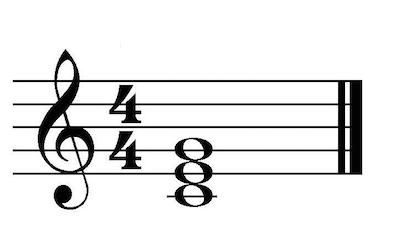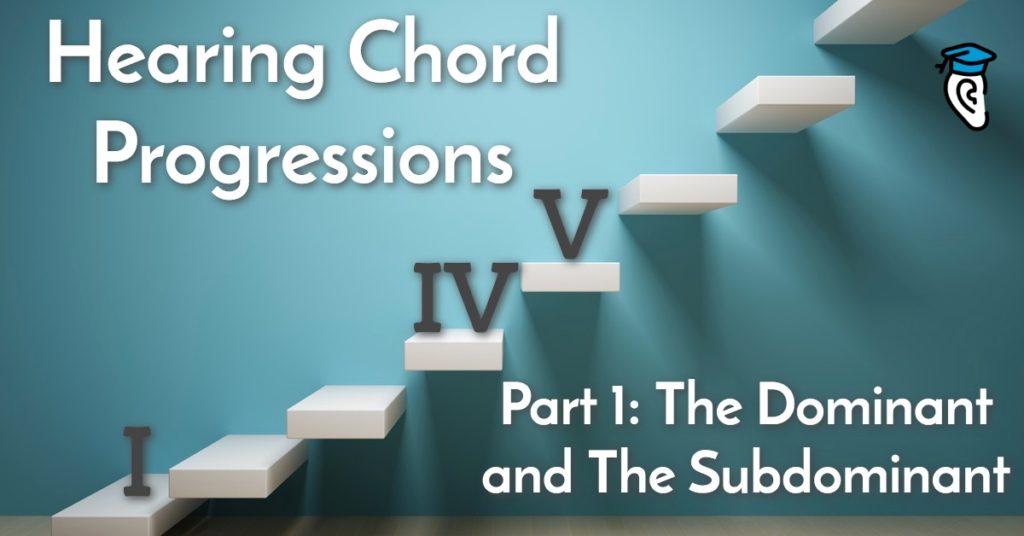These days chord progressions so accessible. Just a few clicks and you can pull the chords for most any song off the internet. That’s great, as long as whoever posted those chords got it right. But how would you like to be able to walk into any musical situation and already know the chords to any song, simply because you brought along your ears? Or easily figure out chords for your next song? When you learn to hear harmonies, this magical skill is well within your grasp.
Bass is the Place
Melody notes, of course, are most easily identified and can be very helpful in identifying harmonies. But the bass in a song most often outlines the root notes of the chord. So often we can figure out entire chords simply by identifying the bass notes, which is what we will mostly focus on here.
The Main Steps in a Scale
In every scale, major or minor, there are main steps and secondary steps. The main steps are, in their exact order of importance, the tonic (I), the dominant (V) and the subdominant (IV). If the key is major, on these main steps we will have major chords. If the key is minor, the chords built on its main steps will be minor. So these three chords express the either the major or minor quality of the given key.
It is said that you can accompany any tonal song only by using the chords built upon these three steps. It is true, because together they contain all the notes from a key. It is also true that a melody is based on secondary steps will somewhat bland if harmonized with only the three main chords. So even if, theoretically speaking, they work, often other chords are substituted which sound more colorful.
But it’s all built on I, IV and V, so we’ll start there.
First Hear the Tonic
Hearing the tonic is fundamental to hearing harmonies. Let’s look at the most important things about the tonic:
- The tonic represents the “home” of a song. The sound on which a song ends is called the “tonic”.
- We use the syllable “do” when we hear the tonic.
- It is the first step of the scale of a song.
- We use it to balance the tension and the release necessary for keeping the music flowing.
If you want a brush-up on hearing the tonic, read these posts:
- Finding the Tonic in Major Keys, Part 1 and Part 2
- Finding the Tonic in Minor Keys, Part 1 and Part 2
Above and Below
You will notice that the dominant and the subdominant can appear below or above the tonic. Of course, changing the octave doesn’t change the function or the role of a chord.
As a warm up, let’s practice different ways of ordering these main steps:
After these exercises, you should be able to recognize the patterns in the next examples.
Hearing the dominant
Remember that the dominant is the fifth step of a key. Let’s practice.
In solfa, do is the tonic. What is the name of the dominant?
Tip: Count five steps, starting with do. The syllable you arrived on at number five is the dominant.
Show answer
Tonic or Dominant: Which is Which?
The dominant, when played by itself, can be confused with the tonic. Some people will actually sing the dominant at the end of a song. The dominant “blends” with the sound of the tonic, so they can mistake it with the “home” of the song.
This is not such a weird thing In fact, because the dominant, which is a fifth from the tonic, is present in the series of overtones very close to the tonic, so it’s very present in its sound. In fact, there’s a whole music theory built on the fifth.
When we hear a sound, we hear a lot of frequencies, but the loudest one is called the fundamental. The rest of the sounds we unconsciously hear are called overtones.
So when we are building chords based on stacked thirds, we are actually emphasizing sounds already contained in the fundamental.
So when you sing the dominant over the tonic in a song, you might feel at “home” because the fundamental sound of the dominant is the fifth of the chord built on the tonic:


It might not be your issue, but confusing dominant for tonic is a surprisingly common problem.
Tonic and Dominant: the Musical Playmates
Let’s assume that you don’t have problems in telling if you’re singing the right sound or not and let’s play a little with the dominant and the tonic.
The first step is to identify what the dominant sounds like. Listen to the next diatonic scale. The piano will be playing the whole scale, and the voice will emphasize the tonic and the dominant. After that, we will directly sing the tonic and the dominant.
When you hear the tonic, sing do and when you hear the dominant sing sol.
Now sing the emphasized sounds in this order: tonic-dominant-tonic. It is important to return to the tonic, because the whole concept of hearing the intervals is relative. We must establish some fixed orientation points and the tonic is what we need in this case.
More Practice with Tonic and Dominant
Sing with these examples:
Here you heard the dominant sung above the tonic. A common practice is to play the dominant below the tonic, and then it sounds like this:
You’ve heard it in many songs, especially in those starting with an upbeat. Anthems often start with an upbeat.
The first two notes of the Romanian anthem are exactly the dominant and the tonic of a minor key, but here the dominant is below the tonic, like this:
Now let’s see how this sounds going from the tonic towards the dominant:
On the lyrics “de bon matin” we have the progression: do do-sol (on the syllable “ma-”) –do (on the syllable “-tin”). Again we can hear the dominant below the tonic. And don’t forget to notice that this song is in a minor key:
“Deseapte-te, Romane” and “La marche des rois” are two great interval reference songs for the perfect fourth (which is, after all, an inverted fifth)
Hearing the Subdominant
Another very important sound in the development of a melody is the subdominant. As stated before, the subdominant is the fourth step of a key.
Question: What syllable do we use in solfa for subdominant?
Show answer
Let’s sing the major scale and emphasize the fourth:
There is a powerful acoustic relationship between the subdominant and the tonic, because the tonic is the fifth of the subdominant triad—similar to the tonic-dominant relation.
Observation: Since the fifth is so important to musical relationships, you can notice that the dominant is one fifth above the tonic and the subdominant is one fifth below the tonic. Knowing this will help in Part 2, when we discuss more about chord progressions.
Subdominant Exercises
Now let’s try to identify the sonority of the subdominant in a few songs:
Let It Be
Let’s begin with one of the most famous pop melodies of all time:
The first two chords are not tonic-subdominant in this example, but tonic-dominant. In the melody, the dominant is sung below the tonic. But at the end of most of the sections you can hear this emblematic “Let it be” motif:
Back in USSR
We also hear this in the next example—in the bass line—between [0:18] and [0:20]:
Here the subdominant is above the tonic:
If you didn’t hear it clearly enough, sing the “do-fa”, as in our example. Count four beats on each note.
Blaze of Glory
Here the chorus also contains the tonic and subdominant, but in an inverted form.
Hum the first note you hear in the bass line of the chorus [1:45]. That’s the fa of the scale, the subdominant. The next note you hear in the bass line is the tonic.
This is what you heard in the bass line:
Although the song starts in a minor key, the chorus is in D Major.
Call Me the Breeze
In this Lynyrd Skynyrd song, very blues-inspired, you can hear a clear tonic-subdominant progression starting at [0:30] and ending at [0:36].
Try to hum the first notes you hear from each bar. Now this is a tough one, because the bass is very melodic and you have to be fast in hearing the first note of each bar.
This is actually a standard blues progression.
Question: What are the actual notes?
Show answer
And at [0:37] you can hear how the melody comes back “home”, to the tonic.
Born in the U.S.A.
Here the subdominant is placed below the tonic:
You can hear the subdominant very well while listening to the bass line of the intro and chorus. The song starts with the tonic. The first appearance of the subdominant chord is at [0:17]. In the chorus at [0:41] you can hear the tonic, and again the subdominant at [0:48].
This is what you heard:
Three Magic Steps
Here’s one last exercise—a preview to Hearing Chord Progressions, Part 2.
Write down the root notes of the chords used in the first four measures of the next song:
Hint
Next time you’re figuring out a song by ear, transcribing, playing the blues or at a jam session, try this: rather than trying to hear and identify each individual chord, listen for the bass line “melody” of the tonic, dominant, and subdominant. Hear these three simple notes and, in most cases, you’ve practically identified 90-100% of the chord progression in any given song. In Part 2 we will look further into these chord progressions themselves.







